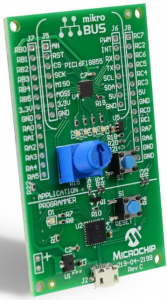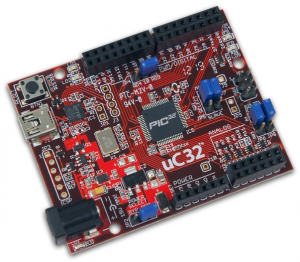Flowcode 7 NEW FEATURE – easy programming for Microchip hardware
This summer, Flowcode 7 will be launched with a range of exciting new features. Part of Flowcode’s appeal is the ability it gives to relative novices to microcontroller programming, to develop complex electronic systems, easily.
Version 7 will be the most user-friendly version yet with a range of help and support features that will assist simple hardware developers with their projects. One of the most impressive version 7 features is the fact that users will have access to a range of pre developed templates for a number of popular Microchip development boards.
What’s even more exciting, is the fact that users will be able to access these templates in the free version of Flowcode 7.
The free version is excellent for learning programming, developing applications at home or for prototyping designs. The free version is restricted with limited features, components and target devices and the fact that it doesn’t give the user commercial licence rights or the ability to use the software in an educational institution.
Flowcode gives users a clear and flexible way of programming microcontrollers, which differs from textual based languages including C++, C# etc. and is easier to use than complex, algorithm engineering type packages such as LabVIEW and MATLAB.
What’s more, with a free version available for home users and in-expensive modular licencing for those wishing to work with further features, commercially or in educational institutions, Flowcode 7 is the perfect way to speed up system design and begin smarter programming.
What is a template in Flowcode?
The use of template files allows Flowcode users to get up and running quickly and easily. They are ideal for new users as they feature 3D graphical representations of the development boards, complete with working components, such as switches, LEDs, potentiometers. Alongside looking and feeling like the real thing, template files also come preconfigured for downloading to hardware, so any registers, compiler and programmer settings and other options are already set. With a template file you can have your first microcontroller program working in minutes!
Microchip templates
Working hand in hand with Microchip, we have chosen some specific development boards which will be available as templates in Flowcode 7. This includes the Curiosity Starter Kit for PIC MCU’s (DM164137). Curiosity is a cost-effective, fully integrated 8-bit development platform targeted at first-time users, Makers, and those seeking a feature-rich rapid prototyping board. Below, you can see a (BETA) screen grab of the Curiosity board in version 7. For each template file, a very simple example has also been created, which users can test before writing their own code.
On top of the Curiosity, a template is also provided for the new Microchip XPress development board (see below, right) and a range of other Microchip hardware to be announced in the weeks leading up to Flowcode 7 launch. One other development board likely to feature is a 32bit device such as the chipKIT uC32 by Digilent (see below, left) which has the same form factor as the Arduino Uno board and is compatible with Arduino shields.
Other PIC device support
Whilst the free version of Flowcode gives users access to the templates, users can gain access to a whole host of other Microchip hardware through purchasing a licence. Flowcode 7 licences will be available to purchase in a modular format, meaning you only need to buy the licence parts that you require, at www.matrixtsl.com.
Flowcode 7 will include support for 8bit, 16bit and 32bit PIC devices, whilst also giving Atmel device support including the ability for users to program Arduino boards. Flowcode has support 8 and 16bit devices for previous versions, whilst 32bit is a new area of appeal for the software.
There will be continued support in Flowcode 7 for Matrix’s range of E-blocks hardware boards including the EB006 PIC multi-programmer and EB091 dsPIC multi-programmer devices plus the FlowKit 2 which features Matrix’s very own Ghost Technology. You can find out more about how Ghost and the other debugging features of Flowcode 7 in this article; Electronic system debugging using Flowcode 7
Microchip’s 32-bit portfolio with the MIPS microAptiv or M4K core offer high performance microcontrollers, and all the tools needed to develop your embedded projects. With some inexpensive development boards now on the market for 32bit PIC including the chipKIT range, we can see the PIC32 offering becoming more popular with those who require more processing power in their developments using Flowcode 7.
Microchip XC compilers
What’s more, we have been working with Microchip to ensure that Microchip XC compilers are included in Flowcode 7, improving the speed at which 8bit PIC devices compile by more than ten times compared to previous versions of the software.
The inclusion of these compilers in Flowcode 7 means more appeal to not only educational users, who are able to ready themselves for industrial applications by use of a professional level compiler but also to those practicing engineers who now have the capability to use Flowcode in the knowledge that the production of highly optimised code is going to be produced as a result. You can find out more about Microchip’s MPLAB XC Compilers here.
Don’t forget Flowcode 7 is available this summer and gives users the ability not only to produce electronics system designs for Microchip’s PIC range and Atmel AVR devices including Arduino, but also ARM based MCU’s. Throughout the coming weeks we will be publishing further articles designed to show you the plans for Flowcode 7.
13,804 total views, 1 views today
Related Posts
-
 RGB LED Pixel Touch Reactive Gaming Table
1 Comment | Apr 7, 2016
RGB LED Pixel Touch Reactive Gaming Table
1 Comment | Apr 7, 2016 -
 FREE Intro to microcontroller programming course
No Comments | Apr 4, 2016
FREE Intro to microcontroller programming course
No Comments | Apr 4, 2016 -
 Mechanical Engineers and Flowcode 7 – PWM using Flowcode
2 Comments | Oct 18, 2016
Mechanical Engineers and Flowcode 7 – PWM using Flowcode
2 Comments | Oct 18, 2016 -
 Formula AllCode and LabVIEW
No Comments | Jan 4, 2016
Formula AllCode and LabVIEW
No Comments | Jan 4, 2016




Thanks for the good info and update
Is it possible to use ِArduino’s examples within Flowcod7? what is the way?
Hi Mohammed. Of course, yes you can use Arduino with Flowcode 7. You can also find more information and help with Flowcode 7 in our supprot resources: http://www.matrixtsl.com/flowcode/support/ including our getting startered guide: http://www.matrixtsl.com/resources/files/datasheets/fc7-getting-started-guide.pdf